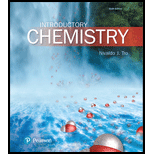
Concept explainers
Interpretation:
The freezing and boiling points of the final solution of ethylene glycol solution which is diluted are to be calculated.
Concept Introduction:
Molarity is the ratio of the number of moles of solute to the liter of solution.
Mathematically, molarity
The concentration of the solution can be expressed in terms of the molality
Molality is the number of moles of solute to the mass of solvent.
The mass of the solvent should be in kilograms
Formula of molality is:
Freezing point is the temperature at which liquid state changes to solid state.
The freezing point depression is:
Here,
molality of the solution in
constant for the solvent.
For water:
The temperature at which vapor pressure of the liquid becomes equal to the
atmospheric pressure is known as boiling point.
The boiling point elevation is:
Here,
molality of the solution in
constant for the solvent.
For water:
Want to see the full answer?
Check out a sample textbook solution
Chapter 13 Solutions
Introductory Chemistry (6th Edition)
- Solutions Introduced directly into the bloodstream have to be isotonic with blood; that is, they must have the same osmotic pressure as blood. An aqueous NaCl solution has to be 0.90% by mass to be isotonic with blood. What is the molarity of the sodium ions in solution? Take the density of the solution to be 1.00 g/mL.arrow_forwardThe freezing point of a 0.21 m aqueous solution of H2SO4 is -0.796C. (a) What is i? (b) Is the solution made up primarily of (i) H2SO4 molecules only? (ii) H+ and HSO4- ions? (iii) 2H+ and 1SO42- ions?arrow_forwardWhen two beakers containing different concentrations of a solute in water are placed in a closed cabinet for a time, one beaker gains solvent and the other loses it, so that the concentrations of solute in the two beakers become equal. Explain what is happening.arrow_forward
- An aqueous solution is 20.0% by mass of sodium thiosulfate pentahydrate, Na2S2O35H2O. What is the molarity of Na2S2O3 in this solution at 20C? The density of this solution at 20C is 1.174g/mL.arrow_forwardConsider three test tubes. Tube A has pure water. Tube B has an aqueous 1.0 m solution of ethanol, C2H5OH. Tube C has an aqueous 1.0 m solution of NaCl. Which of the following statements are true? (Assume that for these solutions 1.0m=1.0M.) (a) The vapor pressure of the solvent over tube A is greater than the solvent pressure over tube B. (b) The freezing point of the solution in tube B is higher than the freezing point of the solution in tube A. (c) The freezing point of the solution in tube B is higher than the freezing point of the solution in tube C. (d) The boiling point of the solution in tube B is higher than the boiling point of the solution in tube C. (e) The osmotic pressure of the solution in tube B is greater than the osmotic pressure of the solution in tube C.arrow_forwardSodium chloride (NaCl) is commonly used to melt ice on roads during the winter. Calcium chloride (CaCl2) is sometimes used for this purpose too. Let us compare the effectiveness of equal masses of these two compounds in lowering the freezing point of water, by calculating the freezing point depression of solutions containing 200. g of each salt in 1.00 kg of water. (An advantage of CaCl2 is that it acts more quickly because it is hygroscopic, that is. it absorbs moisture from the air to give a solution and begin the process. A disadvantage is that this compound is more costly.)arrow_forward
- Calculate the molality of a solution made by dissolving 115.0 g ethylene glycol, HOCH2CH2OH, in 500. mL water. The density of water at this temperature is 0.978 g/mL. Calculate the molarity of the solution.arrow_forwardYou have read that adding a solute to a solvent can both increase the boiling point and decrease the freezing point. A friend of yours explains it to you like this: The solute and solvent can be like salt in water. The salt gets in the way of freezing in that it blocks the water molecules from joining together. The salt acts like a strong bond holding the water molecules together so that it is harder to boil. What do you say to your friend?arrow_forward
 General Chemistry - Standalone book (MindTap Cour...ChemistryISBN:9781305580343Author:Steven D. Gammon, Ebbing, Darrell Ebbing, Steven D., Darrell; Gammon, Darrell Ebbing; Steven D. Gammon, Darrell D.; Gammon, Ebbing; Steven D. Gammon; DarrellPublisher:Cengage Learning
General Chemistry - Standalone book (MindTap Cour...ChemistryISBN:9781305580343Author:Steven D. Gammon, Ebbing, Darrell Ebbing, Steven D., Darrell; Gammon, Darrell Ebbing; Steven D. Gammon, Darrell D.; Gammon, Ebbing; Steven D. Gammon; DarrellPublisher:Cengage Learning Chemistry: The Molecular ScienceChemistryISBN:9781285199047Author:John W. Moore, Conrad L. StanitskiPublisher:Cengage Learning
Chemistry: The Molecular ScienceChemistryISBN:9781285199047Author:John W. Moore, Conrad L. StanitskiPublisher:Cengage Learning General, Organic, and Biological ChemistryChemistryISBN:9781285853918Author:H. Stephen StokerPublisher:Cengage Learning
General, Organic, and Biological ChemistryChemistryISBN:9781285853918Author:H. Stephen StokerPublisher:Cengage Learning Chemistry: Principles and ReactionsChemistryISBN:9781305079373Author:William L. Masterton, Cecile N. HurleyPublisher:Cengage Learning
Chemistry: Principles and ReactionsChemistryISBN:9781305079373Author:William L. Masterton, Cecile N. HurleyPublisher:Cengage Learning Chemistry & Chemical ReactivityChemistryISBN:9781337399074Author:John C. Kotz, Paul M. Treichel, John Townsend, David TreichelPublisher:Cengage Learning
Chemistry & Chemical ReactivityChemistryISBN:9781337399074Author:John C. Kotz, Paul M. Treichel, John Townsend, David TreichelPublisher:Cengage Learning Chemistry & Chemical ReactivityChemistryISBN:9781133949640Author:John C. Kotz, Paul M. Treichel, John Townsend, David TreichelPublisher:Cengage Learning
Chemistry & Chemical ReactivityChemistryISBN:9781133949640Author:John C. Kotz, Paul M. Treichel, John Townsend, David TreichelPublisher:Cengage Learning





